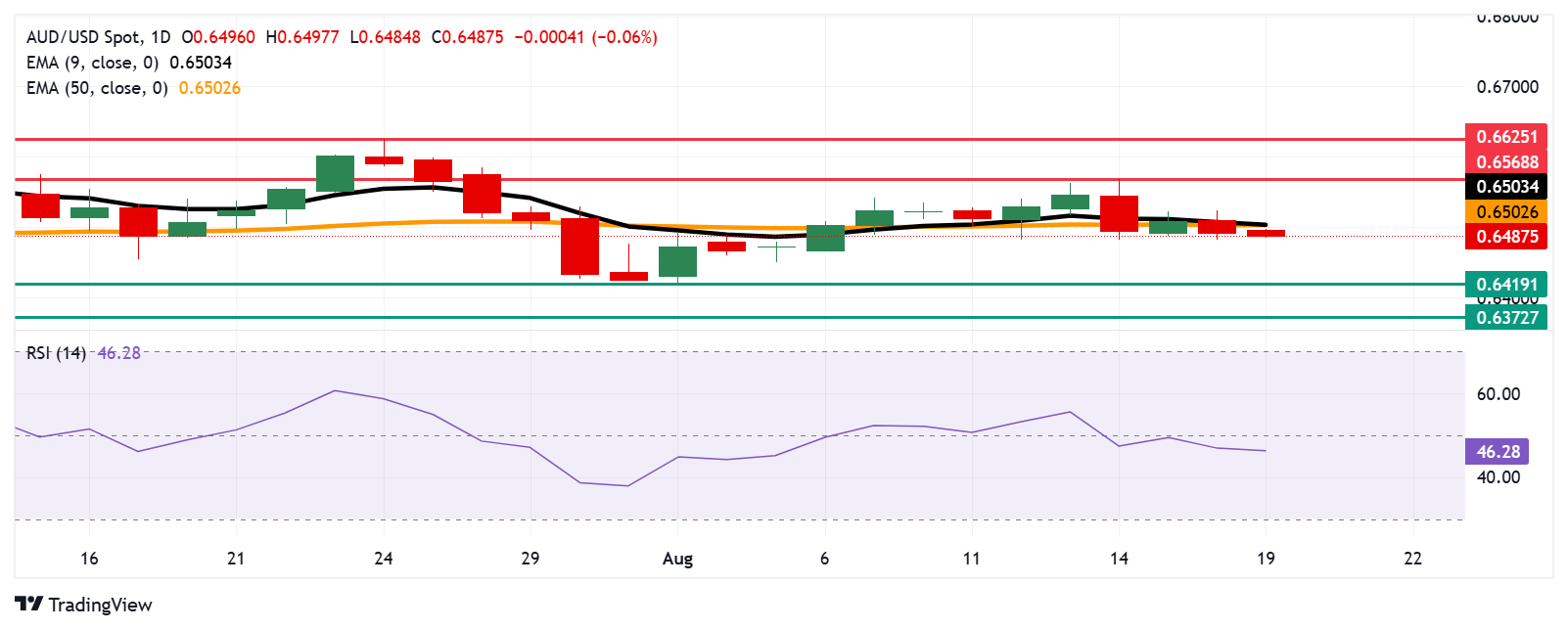Australian Dollar remains subdued despite improved Westpac Consumer Confidence

- The Australian Dollar depreciates as the US Dollar gains ground on geopolitical developments.
- Australia’s Westpac Consumer Confidence jumped 5.7% in August to 98.5, its highest level since February 2022.
- President Trump has begun preparatory steps for a trilateral meeting with Russian President Putin and Ukrainian President Zelenskyy.
The Australian Dollar (AUD) extends its losses for the second consecutive session on Tuesday. The AUD/USD pair depreciates despite an improved Westpac Consumer Confidence, which surged 5.7% in August to 98.5, following a 0.6% increase in July. The sentiment has reached a high since February 2022, as the Reserve Bank of Australia (RBA) has delivered rate cuts totaling 75 basis points since January.
Matthew Hassan, Head of Australian Macro-Forecasting, said the prolonged period of consumer pessimism may be coming to an end, although maintaining momentum could require additional easing. However, he emphasized that policymakers are under no immediate pressure to deliver further cuts.
The AUD/USD pair depreciates as the US Dollar (USD) continues to improve amid geopolitical developments. US President Donald Trump would begin the preparation steps for a trilateral meeting between Russian President Vladimir Putin, Ukrainian President Volodymyr Zelenskyy, and himself at some point soon. Trump also said that Putin agreed to accept security guarantees, and there is a need to discuss possible territory exchanges.
Australian Dollar declines as US Dollar strengthens on eased geopolitical tensions
- The US Dollar Index (DXY), which measures the value of the US Dollar against six major currencies, is gaining ground for the second consecutive session and trading around 98.20 at the time of writing. Traders await the Jackson Hole Economic Policy Symposium, with Fed Chair Jerome Powell’s speech for guidance on a September policy decision.
- Ukraine’s President Volodymyr Zelenskiy late Monday emphasized the need for true peace and welcomed US involvement in security guarantees. Zelenskyy also confirmed major US arms purchase plans. Furthermore, US Secretary of State Marco Rubio said on Tuesday that he would work with European allies and non-European countries on security guarantees for Ukraine.
- The Trump administration has broadened its 50% tariffs on steel and aluminum imports, taking effect on August 18. Friday’s notification has included 407 new product codes in the US Harmonized Tariff Schedule. US President Donald Trump also told reporters he intends to issue further announcements on steel tariffs, along with new levies aimed at semiconductor imports.
- The preliminary Michigan Consumer Sentiment Index fell to 58.6 in August from 61.7 in July, falling short of the expected 62.0 reading. Meanwhile, the US Retail Sales grew by 0.5% month-over-month in July, as expected, against a rise of 0.9% seen in June. Retail Sales Control Group rose by 0.5%, compared to the 0.8% increase prior.
- US Treasury Secretary Scott Bessent said in an interview on Wednesday that short-term Fed interest rates should be 1.5-1.75% lower than the current benchmark rate at an effective 4.33%. Bessent added that there is a good chance the central bank could opt for a 50-basis-point rate cut in September.
- US Treasury Secretary Scott Bessent said on Wednesday that US and Chinese trade officials will meet again within the next two to three months to discuss the future of their economic ties. “The US would need to see sustained progress on curbing fentanyl flows from China, potentially over months or even a year, before considering tariff reductions,” Bessent said.
- The Reserve Bank of Australia (RBA) delivered a 25 basis points (bps) interest rate cut on Tuesday, as widely expected, bringing the Official Cash Rate (OCR) to 3.6% from 3.85% at the August policy meeting.
Australian Dollar moves below confluence zone around 0.6500
AUD/USD is trading around 0.6490 on Tuesday. The technical analysis on the daily chart suggests that short-term price momentum is weaker as the pair is positioned below the nine-day Exponential Moving Average (EMA). Moreover, the 14-day Relative Strength Index (RSI) remains below the 50 level, suggesting that market bias is bearish.
On the downside, the AUD/USD pair may navigate the region around the two-month low of 0.6419, recorded on August 1, followed by the three-month low of 0.6372.
The immediate barrier appears at the psychological level of 0.6500, aligned with the 50-day EMA at 0.6502 and the nine-day EMA at 0.6503. A break above this crucial resistance zone could improve the medium- and short-term price momentum and support the pair to target the monthly high at 0.6568, reached on August 14, followed by the nine-month high of 0.6625, which was recorded on July 24.
AUD/USD: Daily Chart

Australian Dollar PRICE Today
The table below shows the percentage change of Australian Dollar (AUD) against listed major currencies today. Australian Dollar was the weakest against the Japanese Yen.
| USD | EUR | GBP | JPY | CAD | AUD | NZD | CHF | |
|---|---|---|---|---|---|---|---|---|
| USD | 0.08% | 0.08% | 0.01% | 0.07% | 0.13% | -0.00% | 0.04% | |
| EUR | -0.08% | -0.01% | -0.17% | -0.01% | -0.04% | -0.07% | -0.03% | |
| GBP | -0.08% | 0.00% | -0.28% | 0.02% | 0.02% | -0.06% | -0.02% | |
| JPY | -0.01% | 0.17% | 0.28% | 0.12% | 0.20% | 0.02% | 0.10% | |
| CAD | -0.07% | 0.00% | -0.02% | -0.12% | 0.07% | -0.07% | -0.02% | |
| AUD | -0.13% | 0.04% | -0.02% | -0.20% | -0.07% | -0.07% | -0.03% | |
| NZD | 0.00% | 0.07% | 0.06% | -0.02% | 0.07% | 0.07% | 0.04% | |
| CHF | -0.04% | 0.03% | 0.02% | -0.10% | 0.02% | 0.03% | -0.04% |
The heat map shows percentage changes of major currencies against each other. The base currency is picked from the left column, while the quote currency is picked from the top row. For example, if you pick the Australian Dollar from the left column and move along the horizontal line to the US Dollar, the percentage change displayed in the box will represent AUD (base)/USD (quote).
Economic Indicator
Westpac Consumer Confidence
The Westpac Consumer Confidence released by the Faculty of Economics and Commerce Melbourne Institute captures the level of sentiment that individuals have in economic activity reflecting respondents' evaluations of their family finances over the past and coming year, expectations about the one-year and five-year economic conditions and views about current buying conditions for major household items. Generally speaking, a high reading is seen as positive (or bullish) for the AUD, whereas a low reading is seen as negative (or bearish).
Last release: Tue Aug 19, 2025 00:30
Frequency: Monthly
Actual: 5.7%
Consensus: -
Previous: 0.6%
Source: University of Melbourne







